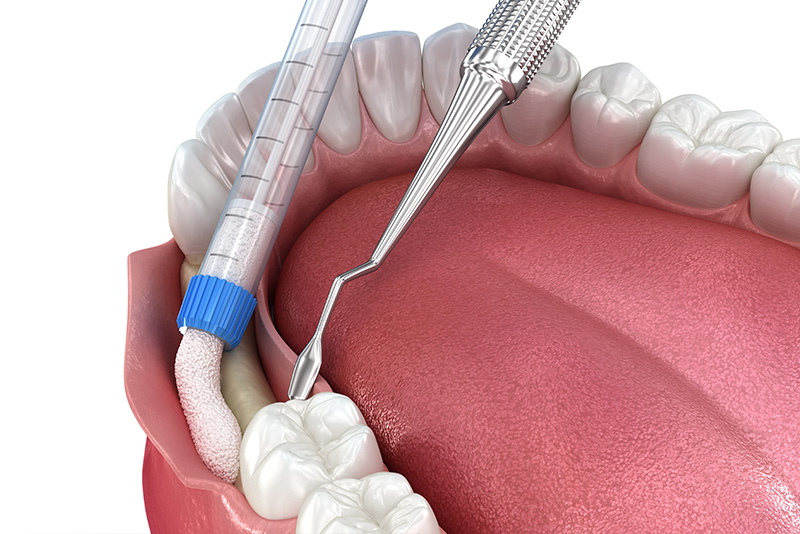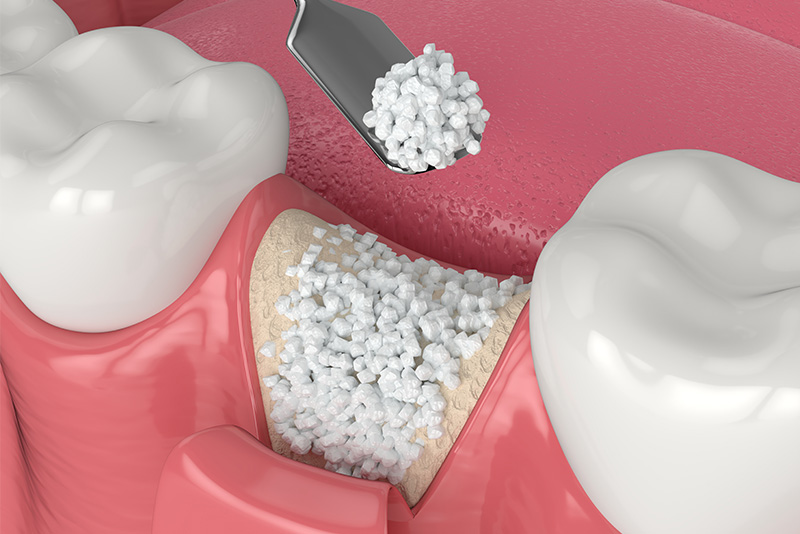Bone loss in the jaws and around the teeth may be the result of missing teeth, a congenital anomaly, periodontal disease, or trauma. More than just a detriment to oral health and function, bone loss can also affect one's appearance by nature of the defect, or diminished support for the natural contours of the face.
By performing grafting procedures, our oral and maxillofacial surgeon can help restore the bone to its original dimensions to improve facial esthetics, rebuild tissue support, and restore function. Bone grafting also facilitates the successful placement and longevity of dental implants.
A bone graft essentially provides the platform or "scaffolding" for new bone growth to occur. Today, bone graft materials come from a variety of sources. Bone for a graft might be collected from another area of the body, harvested from other natural sources, or made of synthetic materials. The choice depends upon the specific needs of the case.
How the graft is performed also varies. While socket preservation involves the placement of a bone graft directly into an extraction site, onlay grafts are laid directly over the area of the bony defect. And, in cases where large bony defects are present, an autogenous graft using the patient's bone may be indicated. The exact size of the defect determines from what part of the body the autogenous bone will be obtained.


Several types of grafting procedures are performed depending upon the particular needs of the case.
Socket preservation is a procedure designed to reduce the bone loss or resorption that follows teeth extraction. Its purpose is to maintain the integrity, volume, and natural contours of the alveolar bone surrounding and supporting the teeth. Typically performed following tooth extraction, the procedure facilitates successful dental implant placement and helps to ensure long-lasting and stable results.
When a tooth is extracted, the natural stimulation to the underlying bone generated by the forces of biting or chewing is lost. As a result, bone width in and around the extraction site can be reduced by as much as 25% in the first year following tooth loss.
Ridge preservation is a procedure designed to retain the soft tissue and bone structure at the site of an extracted tooth. After a tooth is removed, bone-grafting material is placed in the socket to promote healing and encourage new bone development. Maintaining adequate bone and supporting the soft tissues following tooth extraction with a ridge preservation procedure facilitates the successful placement of a dental implant.
The bone that surrounds the roots of the teeth is known as the alveolar ridge. A ridge augmentation is a surgical procedure performed to restore the normal height and width of the alveolar ridge after it has been diminished over time due to tooth loss, denture wear, or trauma. In the presence of a reduced and narrowed alveolar ridge, the primary consideration is how it potentially affects the placement of a dental implant or another dental prosthesis.
A ridge augmentation procedure is performed by placing bone graft material into the tooth socket immediately after a tooth has been removed, or in an existing deficient area as a means to rebuild the shape of the gums and jaw. While in certain situations, dental implants can be placed at the time of a ridge augmentation procedure, they are more often placed after sufficient healing has occurred. By this time, the bone graft has successfully fused with the existing bone, and new bone has formed.
In addition to bone grafting for purposes of ridge preservation or augmentation to allow for dental implants, aesthetic ridge augmentation procedures to restore the natural contours of the bone are sometimes performed in preparation for fixed bridgework to achieve a more cosmetically pleasing result.
To guide tissue regeneration as well as protect the graft and promote healing, the oral and maxillofacial surgeon may place specialized membranes and biologically active materials over the grafting material.
For patients lacking a sufficient amount of bone for a dental implant to replace a maxillary back tooth (upper back tooth), a procedure, which is known as a "sinus lift" is performed. During this surgical procedure, the sinus membrane is lifted, and bone graft material is added between the jaw and the floor of the sinus to provide the needed bone height to support a dental implant successfully.
Depending upon the needs of the case, one of two types of sinus lifts may be performed:
Bone grafting is a surgical procedure that involves placing bone or bone-like materials in areas where bone is missing or has been damaged. This helps promote new bone growth and supports dental implants or other restorative procedures.
Bone grafting may be necessary if you have experienced bone loss due to periodontal disease, tooth loss, trauma, or congenital conditions. It provides the necessary foundation for dental implants or other dental restorations.
There are several types of bone grafts, including autografts (using bone from your own body), allografts (using donor bone), xenografts (using bone from another species), and synthetic grafts made from biocompatible materials.
While some discomfort is expected after the procedure, local anesthesia is administered to minimize pain during the surgery. Your dentist will provide pain management options to help you feel comfortable during recovery.
Recovery time varies depending on the individual and the extent of the graft. Typically, initial healing takes a few weeks, but it may take several months for the graft to integrate fully with the existing bone before proceeding with implants.
Bone grafting is generally very successful, with high rates of integration and healing. Your dentist will assess your specific case to provide an informed outlook on the success of the procedure.
After the procedure, you may need to stick to a soft food diet for a short period to avoid placing stress on the graft site. Your dentist will provide dietary recommendations to ensure proper healing.
Your dentist may prescribe antibiotics to prevent infection and pain relief medications to manage discomfort after the procedure. Be sure to follow all post-operative care instructions for the best recovery.
Bone grafting enhances the foundation for dental implants and improves the overall health of your jawbone, making future dental procedures more successful and effective.
A consultation with your dentist is the best way to determine if bone grafting is necessary. They will evaluate your dental health and discuss your options based on your unique needs and circumstances.